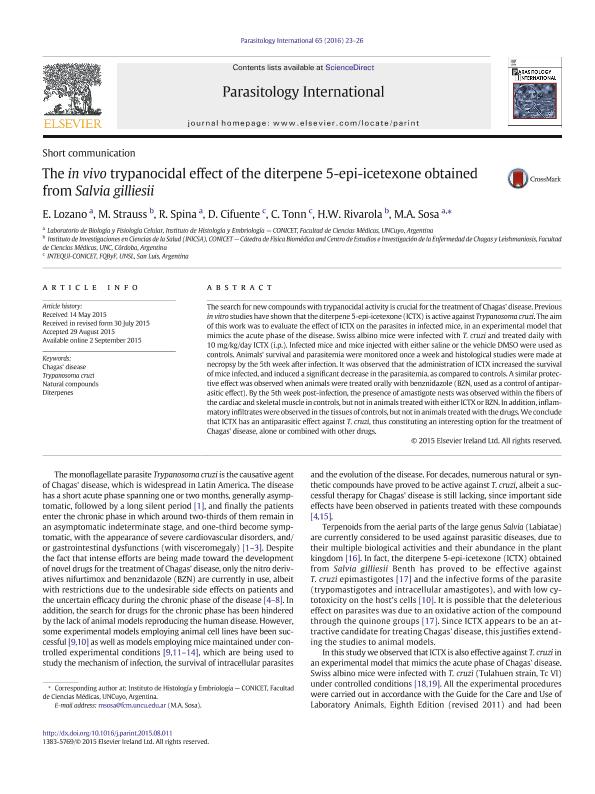Mostrar el registro sencillo del ítem
dc.contributor.author
Lozano, Esteban Sebastián

dc.contributor.author
Strauss, Mariana

dc.contributor.author
Spina Zapata, Renata María

dc.contributor.author
Cifuente, Diego Alberto

dc.contributor.author
Tonn, Carlos Eugenio

dc.contributor.author
Rivarola, Hector Walter

dc.contributor.author
Sosa Escudero, Miguel Angel

dc.date.available
2016-05-24T18:59:31Z
dc.date.issued
2016-02-02
dc.identifier.citation
Lozano, Esteban Sebastián; Strauss, Mariana; Spina Zapata, Renata María; Cifuente, Diego Alberto; Tonn, Carlos Eugenio; et al.; The in vivo trypanocidal effect of the diterpene 5-epi-icetexone obtained from Salvia gilliesii; Elsevier Ireland; Parasitology International; 65; 1; 2-2-2016; 23-26
dc.identifier.issn
1383-5769
dc.identifier.uri
http://hdl.handle.net/11336/5818
dc.description.abstract
The search for new compounds with trypanocidal activity is crucial for the treatment of Chagas' disease. Previous in vitro studies have shown that the diterpene 5-epi-icetexone (ICTX) is active against Trypanosoma cruzi. The aim of this work was to evaluate the effect of ICTX on the parasites in infected mice, in an experimental model that mimics the acute phase of the disease. Swiss albino mice were infected with T. cruzi and treated daily with 10 mg/kg/day ICTX (i.p.). Infected mice and mice injected with either saline or the vehicle DMSO were used as controls. Animals' survival and parasitemia were monitored once a week and histological studies were made at necropsy by the 5th week after infection. It was observed that the administration of ICTX increased the survival of mice infected, and induced a significant decrease in the parasitemia, as compared to controls. A similar protective effect was observed when animals were treated orally with benznidazole (BZN, used as a control of antiparasitic effect). By the 5th week post-infection, the presence of amastigote nests was observed within the fibers of the cardiac and skeletal muscle in controls, but not in animals treated with either ICTX or BZN. In addition, inflammatory infiltrates were observed in the tissues of controls, but not in animals treated with the drugs. We conclude that ICTX has an antiparasitic effect against T. cruzi, thus constituting an interesting option for the treatment of Chagas' disease, alone or combined with other drugs.
dc.format
application/pdf
dc.language.iso
eng
dc.publisher
Elsevier Ireland

dc.rights
info:eu-repo/semantics/openAccess
dc.rights.uri
https://creativecommons.org/licenses/by-nc-nd/2.5/ar/
dc.subject
CHAGAS' DISEASE
dc.subject
DITERPENES
dc.subject
NATURAL COMPOUNDS
dc.subject
TRYPANOSOMA CRUZI
dc.subject.classification
Parasitología

dc.subject.classification
Ciencias de la Salud

dc.subject.classification
CIENCIAS MÉDICAS Y DE LA SALUD

dc.title
The in vivo trypanocidal effect of the diterpene 5-epi-icetexone obtained from Salvia gilliesii
dc.type
info:eu-repo/semantics/article
dc.type
info:ar-repo/semantics/artículo
dc.type
info:eu-repo/semantics/publishedVersion
dc.date.updated
2016-05-16T20:09:39Z
dc.journal.volume
65
dc.journal.number
1
dc.journal.pagination
23-26
dc.journal.pais
Irlanda

dc.journal.ciudad
Shannon
dc.description.fil
Fil: Lozano, Esteban Sebastián. Consejo Nacional de Investigaciones Científicas y Técnicas. Centro Científico Tecnológico Conicet - Mendoza. Instituto de Histología y Embriología de Mendoza Dr. Mario H. Burgos. Universidad Nacional de Cuyo. Facultad de Ciencias Médicas. Instituto de Histología y Embriología de Mendoza Dr. Mario H. Burgos; Argentina
dc.description.fil
Fil: Strauss, Mariana. Consejo Nacional de Investigaciones Científicas y Técnicas. Centro Científico Tecnológico Conicet - Córdoba. Instituto de Investigaciones en Ciencias de la Salud. Universidad Nacional de Córdoba. Instituto de Investigaciones en Ciencias de la Salud; Argentina
dc.description.fil
Fil: Spina Zapata, Renata María. Consejo Nacional de Investigaciones Científicas y Técnicas. Centro Científico Tecnológico Conicet - Mendoza. Instituto de Histología y Embriología de Mendoza Dr. Mario H. Burgos. Universidad Nacional de Cuyo. Facultad de Ciencias Médicas. Instituto de Histología y Embriología de Mendoza Dr. Mario H. Burgos; Argentina
dc.description.fil
Fil: Cifuente, Diego Alberto. Consejo Nacional de Investigaciones Científicas y Técnicas. Centro Científico Tecnológico Conicet - San Luis. Instituto de Investigaciones en Tecnología Química. Universidad Nacional de San Luis. Facultad de Química, Bioquímica y Farmacia. Instituto de Investigaciones en Tecnología Química; Argentina
dc.description.fil
Fil: Tonn, Carlos Eugenio. Consejo Nacional de Investigaciones Científicas y Técnicas. Centro Científico Tecnológico Conicet - San Luis. Instituto de Investigaciones en Tecnología Química. Universidad Nacional de San Luis. Facultad de Química, Bioquímica y Farmacia. Instituto de Investigaciones en Tecnología Química; Argentina
dc.description.fil
Fil: Rivarola, Hector Walter. Consejo Nacional de Investigaciones Científicas y Técnicas. Centro Científico Tecnológico Conicet - Córdoba. Instituto de Investigaciones en Ciencias de la Salud. Universidad Nacional de Córdoba. Instituto de Investigaciones en Ciencias de la Salud; Argentina
dc.description.fil
Fil: Sosa Escudero, Miguel Angel. Consejo Nacional de Investigaciones Científicas y Técnicas. Centro Científico Tecnológico Conicet - Mendoza. Instituto de Histología y Embriología de Mendoza Dr. Mario H. Burgos. Universidad Nacional de Cuyo. Facultad de Ciencias Médicas. Instituto de Histología y Embriología de Mendoza Dr. Mario H. Burgos; Argentina
dc.journal.title
Parasitology International

dc.relation.alternativeid
info:eu-repo/semantics/altIdentifier/url/http://www.sciencedirect.com/science/article/pii/S1383576915001439
dc.relation.alternativeid
info:eu-repo/semantics/altIdentifier/doi/http://dx.doi.org/10.1016/j.parint.2015.08.011
Archivos asociados
